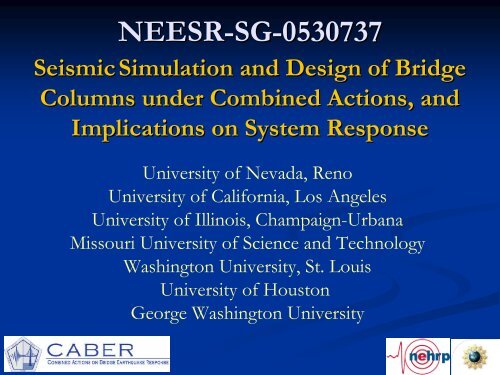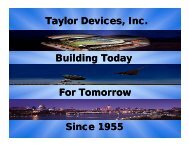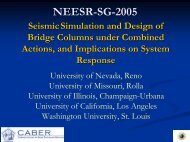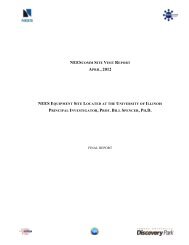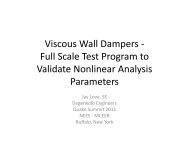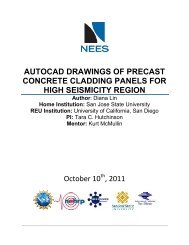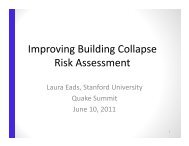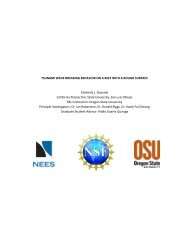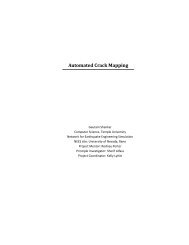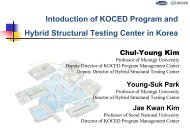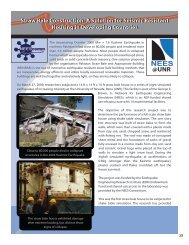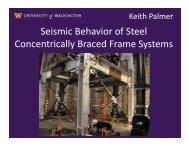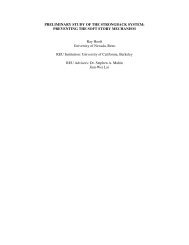Shear Column - NEES
Shear Column - NEES
Shear Column - NEES
- No tags were found...
You also want an ePaper? Increase the reach of your titles
YUMPU automatically turns print PDFs into web optimized ePapers that Google loves.
M-V-T InteractionsTest Points obtained from theexperiments of this research projectM/V=12 ft, T=VariableM/V=6 ft, T=VariableFlexure-<strong>Shear</strong>Pure Torsion<strong>Shear</strong>-TorsionCombination of Flexure-<strong>Shear</strong>-TorsionM-V-T Interaction Surface
Many Potential Parameters• Cross-section - Circle, Interlocking Spiral, Square• <strong>Column</strong> aspect ratio - moment/shear ratio• Torsion/shear ratio - high and low torsion• Level of axial loads• Level of detailing for high and moderate seismicity• Bidirectional bending moment - non-circular crosssections• Type of Loading – Slow Cyclic, Pseudo-dynamic and shaketable/dynamic
FHWA Bridge #4 – Structural Details
FHWA Bridge #8 – Structural Details
Analytical Program• Development Inelastic Models for RC Sectionsunder Combined Loading• Modeling of Specimens• Complex and Simplified Tools• Parametric Studies• Bridge System Analysis• Development of Seismic Design Criteria
Experimental Program• Experimental investigation of columns under multi-directional loadings with varying levels of axial forceand axial-flexure interaction ratios linked to analysis.• Slow cyclic tests at MS&T.• Pseudo-dynamic dynamic tests at UIUC• Dynamic tests at UNR• Integrated bridge test managed by GeorgeWashington and MS&T, tested at UIUC
Experimental Program – Test Matrix to DateGROUPCOLUMN IDReinforcementRatio(% ) (% )<strong>Column</strong>Height(m)Applied LoadAxial <strong>Shear</strong> Bending Torsion(A) (V) (M) (T)Loading Ratiol tM/V T/MM/V(12)-T/M(0) Yes Yes Yes No 12 0M/V(12)-T/M(0.1) Yes Yes Yes Yes 12 0.1M/V(12)-T/M(0.2) Yes Yes Yes Yes 12 0.2I 2.1 0.73 3.7M/V(12)-T/M(0.4) Yes Yes Yes Yes 12 0.4IIIII∞ρρTRANSV.REINF.TYPEM/V(0)-T/M( )M/V(0)-T/M( ∞)-w/HYesYesNoNoNoNoYesYesM=V=0M=V=0 ∞ HoopM/V(12)-T/M(0.2) Yes Yes Yes Yes 12 0.22.1 1.32 3.7M/V(12)-T/M(0.4) Yes Yes Yes Yes 12 0.4M/V(6)-T/M(0) Yes Yes Yes No 6 0M/V(6)-T/M(0.2) Yes Yes Yes Yes 6 0.2M/V(6)-T/M(0.4) 2.1 1.32 1.85 Yes Yes Yes Yes 6 0.4SpiralM/V(6)-T/M(0.6) Yes Yes Yes Yes 6 0.6M/V(0)-T/M ( ∞)Yes No No Yes M=V=0 ∞M/V(0)-T/M(0.4) 2.1 1.01 1.85 Yes No No Yes 6 0.4∞Spiral
Experimental Program – Test SetupStrong Wall Load CellHydralic JackLoad StubTwo HydraulicActuatorsSteel Strands(Inside <strong>Column</strong>)Test Unit3.7 mSupport BlocksStrong Floor610 mm
Results – Cover Spalling with Increasing T/M RatioSpiral Ratio of 0.73%0.54 m0.67 m0.84 m2.43 m3.7 mM/V(12)-T/M(0) M/V(12)-T/M(0.1) M/V(12)-T/M(0.2) M/V(12)-T/M(0.4) M/V(12)-T/M(∞)Increase in Torsional Moment
Work in Progress-Experimental• <strong>Column</strong>s with different design detailing based on torsional designwill be tested under combined bending and torsion.• Testing of columns with interlocking spiral reinforcement undercombined bending and torsion are under development- Development of Analytical Models• Development of damage models for RC columns under combinedloadings• Development of mechanical models based on the STM for RCcircular sections under combined loadings including confinement andspalling effect
University of Houston Contribution• Development of a new fiber beam-columnelement with combined <strong>Shear</strong>/Bending/AxialInteraction• Model based on rotating crack concept withbiaxial strength envelope for concrete• Model accounts for Cyclic & Dynamic/Seismiceffects• Model was calibrated and used for simulation ofRC specimens under static and dynamic loads
Extension of RC Fiber Beams toAccount for <strong>Shear</strong> Effects• Adopt a Timoshenko Beam Formulation with <strong>Shear</strong>Deformations• Impose Equilibrium in Transverse Direction to DetermineConcrete Lateral Strain• Rotate Stresses to Principal (Crack) Directions• Use Concrete Biaxial Constitutive ModelsPcracksElement in CartesianCoordinate System 21 2Element in PrincipalCoordinate SystemStress/Strain ModelIn Principal Directionsσ∈
UIUC Reinforced Concrete Short <strong>Column</strong>250200Green - No <strong>Shear</strong> Effect Included<strong>Shear</strong> Force (kips)<strong>Shear</strong> force (kip)150100500-3 -2 -1 0 1 2 3 4 5-50-100-150-200UIUC‐ Pier1 Dx, Dy & Rz , No <strong>Shear</strong> EffectRed - <strong>Shear</strong> UIUC‐ Pier1 Effect Dx, Dy & Rz , <strong>Shear</strong> IncludedEffectBlue - Experimental-250Displcaement (in)Displacement (in)UIUC‐ Pier1 Dx, Dy & Rz , Experiment Add data
12’MS&T Circular<strong>Column</strong>sShell RegionCore RegionTransverseReinforcementLongitudinalReinforcement24” Dia.140<strong>Shear</strong> Force <strong>Shear</strong> force (kip) (kips)120100806040200UMR 12ft <strong>Column</strong> No <strong>Shear</strong> Effect, rhoS=0.73%UMR 12ft <strong>Column</strong> <strong>Shear</strong> Effect, rhoS=0.73%UMR 6ft <strong>Column</strong> No <strong>Shear</strong> Effect, rhoS=0.73%UMR 6ft <strong>Column</strong> <strong>Shear</strong> Effect, <strong>NEES</strong> 6ft <strong>Column</strong> <strong>Shear</strong> Effect, rhoS=0.73%UMR 6ft <strong>Column</strong> <strong>Shear</strong> Effect, rhoS=1.32%6’ - <strong>Shear</strong> <strong>Column</strong> – with and withoutUMR 12ft <strong>Column</strong> <strong>Shear</strong> Effect, rhoS=0.73%, Experimentshear effects12’ - <strong>Shear</strong> <strong>Column</strong> – with and withoutshear effects, different reinf. ratios0 1 2 3 4 5 6 7 8 9 10Displcaement (in)Displacement (in)
Work in Progress• Extension of model to account for TorsionalEffect.• Calibration of model versus test data provided byMST/UIUC• Use of model to simulate specimens tested atUIUC & UNR• Use of model to conduct further statisticalanalysis on RC columns
UIUC Focus<strong>Shear</strong>-flexural-axial interaction particularly under the presenceof high vertical acceleration• Large scale testing - completed• Pseudo dynamic tests without and with verticalground motion: 2 specimens• Cyclic load tests under different axial load levels: 2specimens• Small scale testing• Numerous small scale piers to be used to furtherexplore moment-axialaxial-shear interaction and loadpath effects: ongoing
Pseudo Dynamic Tests• Configuration and control• Prototype: FHWA design example 4 (1996)• Single ½ scale experimental pier• Analytical model of remaining 3 piers and bridgedeck• Input• Pier 1: Horizontal ground motion• Pier 2: Combined horizontal and vertical groundmotion• Test Results• Vertical ground motion significantly increased thevariation of axial load• Axial load ranged from -3.5% to 20%• Significant increases in shear strains (spiral) anddiagonal cracking were observed when includingthe vertical component• Strong coupling of shear force demand and axialload was observedLateral Force (kip)200150100500-50-100PIER 1PIER 2-150-2 -1 0 1 2 3 4 5Lateral Displ. (in)Pier 1 Pier 2
• Configuration and control• Diameter: 24 in, Height: 102 in• Mixed mode control• Displacement control: lateraldisplacement and rotation• Force control: axial force• Input• Cyclic lateral displacement and zerorotation (double bending)• Constant axial force• Pier 3: tension force of 50 kips• Pier 4: Compression force of250kips• Test Results• Strong coupling between shear forcedemand and axial load• Pier with moderate tension developedductile shear failure• Degradation of shear capacity dominatedresponse of pier with compressionCyclic TestingLateral Force (kip)200150100500-50-1000 2 4 6 8Lateral Displ (in)Pier 3 Pier 4Pier 3Pier 4
Work in Progress• Numerous small scale piers will be used to further investigateshear-flexureflexure-axial interaction• Coupling of load path (lateral and vertical) with shear capacity anddemand will be investigated• Tests will be performed using <strong>NEES</strong>@UIUC 1/5 scale testing facility
UCLA• Conducting Global Modeling of Structures• Development of a robust ABAQUS user elementcapturing the major effects observed in the realistic RCcolumn responses, including the damage prediction andshear-flexural interaction (under constant axial force)• Validation of the user element with 13 static cyclicpushover and 2 dynamic shake table tests has beencompleted.
UCLA• Two new nonlinear user elements, one for shearresponse, another for flexural response, are developed.• Calibrated with 13 static cyclic pushover tests.• Coupled user element simultaneously controlling boththe nonlinear shear-displacement and the nonlinearmoment-rotation responses of RC columns is underdevelopment.• Dynamic loadings requires further examination andvalidation.
Preliminary Conclusions• Bridges with different structural and geometrycharacteristics, the shear-flexural interaction effectsof columns can be quite different.• The general trends are :•Displacement are larger•Section Section forces are smaller.
Work in Progress• Re-running the seismic response analysis of thethree prototype bridges to conclude thenonlinear shear-flexural effects on highwaybridges at the system level.• Generation of fragility curves for the prototypehighway bridges, with and without theconsideration of axial-shearshear-flexural interactions.
George Washington University• To verify local and global nonlinear analytical modelsdeveloped in this project• To investigate types of bridge configurations thatlead to columns with the highest T/M ratio• To investigate these concepts both analytical andexperimental via hybrid simulations
Hybrid Simulation• Hybrid simulation:Integration of analysisand experiment- Simulated experimentally:Three out of eightcolumns using LBCBswith OpenSeesThe proposed prototype bridge is the eighth in a seriesof seismic design examples developed for FHWAwith the earthquake site in Washington State .
UNR Previous Experiments• 1:3 Scale• φ=16’’ , L=72’’• 20 # 4 (ρ=0.020)• #2 @ 1.5’’ (spiral)• Axial load: 80 kips• Increasing El Centro (1/3, 2/3,1, 1.5, 2, 2.5, 3, 3.5, 4).• CALTRANS (1990’s s designprocedure).
OpenSees Results - Bi-directional3530Test uniaxialBase shear (Kips).25201510Model biaxial2.5 El Centro500 2 4 6 8 10Relative displacement (in)Does not include cross coupling.
Bi-directional Mass Rig
Bi-directional Mass Rig• Deck is Connected tothe Top of the <strong>Column</strong>but the Deck is able tomove laterally and rotate.• Hybrid Simulation• Variable Axial Load• Horizontal Actuatorsprovide equivalent P-PDelta and compensationof tendon horizontalforces.
UNR ProgramShape Ht. Scale Design Directions Description104CA,E1,E2 Constant axial, low1:3 High,T shear, torsion104VA,E1,E2 N01 but with variable1:3 High,T axial load72CA,E1,E2 Constant axial, high1:3 High,T shear, torsion72VA,E1,E2 N03 but with variable1:3 High,T axial load72Variable axial, high- 12x20 1:4 High VA,E1,E2shear- 12x20 72VA,E1,E21:4 HighN05 with torsion,T- 12x20 72VA,E3,E4 N06 with near field1:4 High,T motions72VA,E1,E2- 12x20 1:4 HighN07 with high torsion,T2N01 - 16N02 - 16N03 - 16N04 - 16N05N06N07N08
EducationWashington University – St. LouisObjective:To provide undergraduate students with an inquiry-basededucational tool to understand assumptions used in numericalmodeling and their implications by performing a comparison ofnumerical and experimental data.Instructional Goals:• Users select the dimensions of the column they want to examine,e.g. the column geometry, section details, and materialproperties.• Two different analysis methods (linear and non-linear structuralbehavior) are implemented to consider different modeling assumptions.• A comparison between numerical and experimental results canbe performed.
Virtual Experiments…
Virtual Experiments…
Virtual Experiments…• This experiment has been implemented at twouniversities to collect feedback on the instructionaltools. Feedback is being used to revise and improve thetool.• The teaching module will be openly available forinterested educators.• New modules targeting different levels of students arebeing developed to complement this virtual exercise.
Combined Actions on Bridge Earthquake Response


